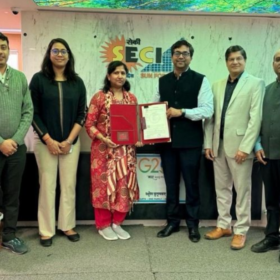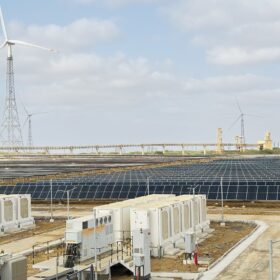India is undergoing a significant electric vehicle (EV) revolution, with ambitious targets aiming for 80 million EVs on the road by 2030. Driven by regulations like FAME and Viability Gap Funding, EV adoption has been rising. This rapid growth has generated a corresponding demand for lithium-ion batteries, estimated to be around 127 GWh by FY30. But this success brings a major challenge: to deal with the increasing number of end-of-life batteries.
In the absence of suitable recycling facilities, India will be under the threat of mounting environmental and economic consequences. Battery recycling is crucial as it facilitates the recuperation of raw materials, reduces environmental contamination, and completes the material cycle. The circular economy in battery recycling is the key to achieving the country’s green transformation and future balance.
What is a circular economy in the EV context?
In the context of EVs, a circular economy shifts from a linear “take-make-dispose” pattern towards more sustainable, “reduce-reuse-recycle” operations.
It’s optimizing resources through the EV lifecycle, focusing on batteries. The circular process also supports EV component remanufacturing and refurbishment to lengthen their lifespan. Implementing these systems within a circular economy for EVs can lead to an enormous waste reduction.
Why battery recycling matters?
The demand and adoption of electric vehicles (EVs) in India is increasing; battery recycling to maintain resource sustainability cannot be overstated. India is now heavily reliant on imported critical metals such as lithium and cobalt. By recycling domestic batteries, this reliance on limited resources is greatly reduced, ensuring a more consistent supply.
By 2030, recycling could meet 80% of India’s lithium and cobalt needs and save the country about $2 billion a year on imports. Furthermore, development of a comprehensive recycling infrastructure supports a circular economy, which mitigates environmental impacts and results in job creation.
India’s policy push & regulatory framework
India focuses on creating a recycling ecosystem through incentives and regulations. Production Linked Incentive (PLI) schemes incentivize additional battery manufacturers who build recycling into the manufacturing process, therefore encouraging green supply chains. Under the Battery Waste Management Rules 2022, the government’s emphasis on traceability and producer accountability adds to the creation of a transparent and formal recycling sector.
Gati Shakti infrastructure projects would enable logistics that will improve the collection and transportation of end-of-life batteries. These initiatives are part of India’s plan to become a world leader in sustainable battery regulation by achieving a 90% recovery rate, or ‘supply chain efficiency,’ on recycling of batteries and material recovery by 2026-27 to support the development of a circular economy in the Indian EV market.
Current state of battery recycling in India
Battery recycling was in its starting stages in India, most of it being done in the unorganized sector with hardly any safety and compliance norms. But the climate is changing quickly. A new generation of startups and incumbent companies are establishing recycling programs that are delivering the professionalism and technological advancement that the marketplace needs. There is a growing interest among the global companies to collaborate with Indian firms to set up recycling units locally in India, being one of the largest EV markets for the future.
Numerous Original Equipment Manufacturers (OEMs) and energy storage companies are building pilot plants to investigate efficient recycling processes and second-life applications. These are indeed positive trends toward a sustainable battery recycling landscape in India.
Technological innovations in battery recycling
Technology is modernizing battery recycling in more efficient and greener ways. Hydrometallurgy is replacing pyrometallurgy for a cleaner process and better resource recovery. High-tech artificial intelligence and robotics are employed for disassembly work and the recovery of used cells; these technologies are meant to reduce the risk of contact with harmful substances.
Second-life batteries used in stationary energy storage are quickly gaining traction. Automation and data processing allow battery lifecycles to be monitored from production to recycling while optimizing the procedure. These technological breakthroughs boost recovery rates while also minimizing environmental impact, thereby confirming India’s major global role.
Challenges ahead
The road to a circular battery economy in India, however, is fraught with various obstacles. Informal disassembly and improper disposal due to the absence of a large-scale, formal system for collecting spent batteries results in environmental damage and human health risks. Minimal consumer knowledge concerning battery recycling also impedes the effective reuse of precious materials.
Moreover, exorbitant costs and technological intricacies associated with recycling limit entry for startups, inhibiting industry expansion. Better coordination between OEMs, recyclers and the government is crucial to overcome these challenges, provide clarity on regulations and set up a strong recycling ecosystem to smoothen India’s transition to the irresistible EV future.
Building a scalable circular ecosystem
Collaboration among OEMs, startups, government authorities and industries will determine the fate of India’s EV battery recycling in the coming future. Embedding recycling in the manufacturing cycle will improve the efficiency of resources, make us less dependent on imports, and stabilize prices. From 2025, a digital battery passport, to include batteries over 2 kWh, will be introduced, enhancing lifecycle traceability and circular actions. Public-private partnerships are crucial to setting up collection networks and recycling parks that can cope with increasing infrastructure.
Conclusion—Powering sustainability through circularity
In conclusion, India is well-placed to advance the e-mobility circular economy in Asia against the backdrop of the fast-growing market and recycling strategies. Adopting the 5Rs—Reduce, Reuse, Repurpose, Remanufacture, and Recycle—can help in reducing resource depletion and waste.
As EVs continue to be adopted, establishing a well-structured recycling system is not a choice but a necessity. India can recover valuable materials, reduce its dependence on raw materials imports, and lower environmental degradation with such a system. There is an urgent need for immediate action to promote a strong circular economy that can help India actualize its ambition of having 80 million vehicles by 2030. With these strategies, India’s growth will be cleaner, sustainable, and economically proactive, benchmarking a global model for sustainable e-mobility.
The views and opinions expressed in this article are the author’s own, and do not necessarily reflect those held by pv magazine.
This content is protected by copyright and may not be reused. If you want to cooperate with us and would like to reuse some of our content, please contact: editors@pv-magazine.com.








By submitting this form you agree to pv magazine using your data for the purposes of publishing your comment.
Your personal data will only be disclosed or otherwise transmitted to third parties for the purposes of spam filtering or if this is necessary for technical maintenance of the website. Any other transfer to third parties will not take place unless this is justified on the basis of applicable data protection regulations or if pv magazine is legally obliged to do so.
You may revoke this consent at any time with effect for the future, in which case your personal data will be deleted immediately. Otherwise, your data will be deleted if pv magazine has processed your request or the purpose of data storage is fulfilled.
Further information on data privacy can be found in our Data Protection Policy.